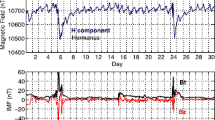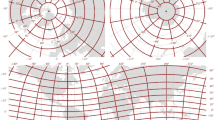Abstract
Specific features of the variations and structure of the ionosphere above northern Europe during the known magnetospheric storm of January 10, 1997, have been analyzed using the oblique-incidence backscatter (OIB) methods. The OIB equipment installed near St. Petersburg, Gor’kovskaya (AANII), represent a BIZON small radar, the data of which were compared with the CUTLASS radar data, GPS observations of TEC, and geophysical data of the Sweden, Finnish, and Russian high-latitude observatories. A local substorm that occurred from 1451 to 1655 UT has been studied in detail, and 52 OIB ionograms have been obtained. The types of reflections from the MIT polar wall and the narrow ionization trough have been identified.
Similar content being viewed by others
References
J. Aarons and B. Lin, “Development of High Latitude Phase Fluctuations during the January 10, April 10–11, and May 15, 1997 Magnetic Storms,” J. Atmos. Sol.-Terr. Phys. 61, 309–327 (1999).
H. F. Bates, Results of the HF Forward and Backscatter Program at Colledge since 1963 (Univ. Alaska, 1966).
D. V. Blagoveshchensky and G. A. Zherebtsov, High-Latitude Geophysical Phenomena and Prediction of HF Radiochannels (Nauka, Moscow, 1987) [in Russian].
D. V. Blagoveshchensky, L. V. Egorova, and V. M. Lukashkin, “High-Latitude Ionospheric Phenomena Diagnostics by High-Frequency Radio Wave Propagation Observations,” Radio Sci. 27(2), 267–274 (1992).
M. J. Buonsanto, “Ionospheric Storms—a Review,” Space Sci. Rev. 88, 563–601 (1999).
K. Davies, Ionospheric Radio (Peter Peregrinus Ltd, London, 1990).
M. G. Deminov, A. T. Karpachev, V. V. Afonin, et al., “Dynamics of the Midlatitude Ionospheric Trough during Storms. 1. Qualitative Pattern,” Geomagn. Aeron. 35(1), 73–79 (1995).
M. G. Deminov, A. T. Karpachev, V. V. Afonin, and S. K. Annakuliev, “Dynamics of the Midlatitude Ionospheric Trough during a Magnetic Storm: Main Phase,” Geomagn. Aeron. 35(6), 69–77 (1995).
N. J. Fox, M. Peredo, and B. J. Thompson, “Cradle to Grave Tracking of the January 6–11, 1997 Sun-Earth Connection Event,” Geophys. Res. Lett. 25, 2461–2464 (1998).
Yu. I. Galperin, L. D. Sivtseva, V. M. Filippov, and V. L. Khalipov, Subauroral Topside Ionosphere (Nauka, Sib. Otd., Novosibirsk, 1990) [in Russian].
B. W. Halcrow and J. S. Nisbet, “A Model of F2 Peak Electron Densities in the Main Trough Region of the Ionosphere,” Radio Sci. 12(5), 815–827 (1977).
R. H. Holzworth and C.-I. Meng, “Mathematical Representation of the Auroral Oval,” Geophys. Res. Lett. 2, 377 (1975).
R. D. Hunsucker, “Auroral and Polar-Cap Ionospheric Effects on Radio Propagation. Mini-Review,” IEEE Trans. Antennas Propag. 40(7), 818–828 (1992).
N. Jakowski, S. Schluter, and E. Sardon, “Total Electron Content of the Ionosphere during the Geomagnetic Storm on 10 January 1997,” J. Atmos. Sol.-Terr. Phys. 61, 299–307 (1999).
M. Lester, T. B. Jones, T. R. Robinson, et al., CUT-LASS—A Tool for Co-Ordinated Cluster/Ground Based Investigations of the Solar Terrestrial System, in Satellite-Ground Based Source Book, Ed. by M. Lockwood, M. N. Wild, and H. J. Opgenoorth (ESA Publ. ESTEC, Noordwijk, 1997), pp. 191–202.
A. M. Mirokhin, N. F. Blagoveshchenskaya, A. V. Shirochkov, and O. A. Troshichev, “The New Russian Advanced Digital Ionosonde—BIZON,” in Ionosonde Network Advisory Group INAG-60 (Australia, 1994), pp. 25–29.
A. S. Rodger, C. Morrell, and J. R. Dudney, “Studies of Sporadic E (Es) Associated with the Main Ionospheric Trough,” Radio Sci. 18(6), 937–946 (1983).
A. S. Rodger, L. H. Brace, W. R. Hoegy, and J. D. Winningham, “The Poleward Edge of the Mid-Latitude Trough—Its Formation, Orientation and Dynamics,” J. Atmos. Sol.-Terr. Phys. 48(8), 715–720 (1986).
A. S. Rodger, R. J. Moffett, and S. Quegan, “The Role of Ion Drift in the Formation of Ionization Troughs in the Mid-and High-Latitude Ionosphere—a Review,” J. Atmos. Sol.-Terr. Phys. 54(1), 1–30 (1992).
J. M. Ruohoniemi and R. A. Greenwald, “Convection Dynamics of Substorm Onset Observed by SuperDARN,” in Proceedings of the 4th International Conference on Substorms, Nagoya, 1998, p. 177.
Space Physics Interactive Data Resource (SPIDR) http://julius.ngdc.noaa.gov.8080/.
Author information
Authors and Affiliations
Additional information
Original Russian Text © D.V. Blagoveshchensky, V.A. Kornienko, 2007, published in Geomagnetizm i Aeronomiya, 2007, Vol. 47, No. 2, pp. 242–253.
Rights and permissions
About this article
Cite this article
Blagoveshchensky, D.V., Kornienko, V.A. Studying the ionosphere with the incoherent scatter radar during the magnetic storm of January 10, 1997. Geomagn. Aeron. 47, 227–237 (2007). https://doi.org/10.1134/S0016793207020119
Received:
Accepted:
Issue Date:
DOI: https://doi.org/10.1134/S0016793207020119




